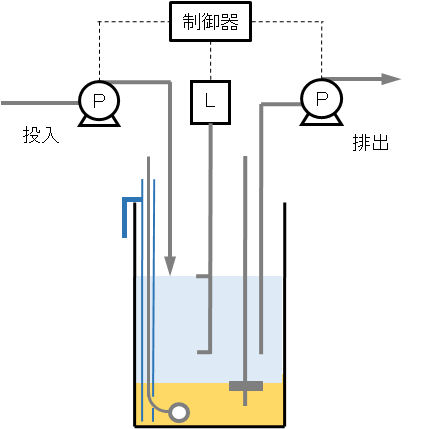Activated sludge process – indoor batch experiment
村上定瞭(水浄化フォーラム), Sadaaki Murakami (Water & Solutions Forum)
1.はじめに
2.実験方法
3.運転管理と操作条件
4.実験の自動化
5.DO・BOD・窒素の挙動
分析項目
活性汚泥法の総目次
Ⅰ. 活性汚泥法とは
Ⅱ. 基本設計・操作因子
Ⅲ. 回分法(本ページ)
Ⅳ. 連続法
Ⅴ. 活性汚泥の悪化と対策
1. Introduction
2. Experimental
3. Operation management and operating conditions
4. Experiment automation
5. Behavior of DO, BOD and Nitrogen
Analysis item
Total table of activated sludge process
I. What is the activated sludge process?
Ⅱ. Basic design and operation factors
Ⅲ. Batch method (this page)
Ⅳ. Continuous method
Ⅴ. Deterioration of activated sludge and countermeasures
1.はじめに
微生物を用いた水の浄化方法には、培養形式によって水中に微生物を懸濁状態で維持する浮遊型と担体(様々な形状とサイズがある)に付着状態で維持する付着型がある。浮遊型には、次のような特徴がある。
①単位容積あたりの微生物濃度を高く保持できるとともに、汚濁物質と微生物の接触が効果的で、高い処理能力が期待できる。
②プロセスの設計や維持管理において、微生物濃度や汚濁負荷などを正確に制御できる。
ここでは、バケツを用いた回分式の活性汚泥法の実験方法を記載する。好気性微生物を用いた代表的な浄化方法である活性汚泥プロセスの基本設計と維持管理の項目について、初心者が実践的に理解することが目的である。
この方法は運転が簡便であることに加え、現場で稼働している活性汚泥プロセスの改善や問題点の解決の上でも、この実験手法はとても参考となる。曝気槽内の生物反応の経時変化を測定できるので、様々な研究実験にも活用されている。
本ページでは、実験に係る事項のみ記載するので、初心者は活性汚泥法に係る「用語や運転・操作因子」は総目次のⅠ.基本設計・操作因子を参照されたい。初心者が、本法に係る屋内実験を実施すると、様々な原因により「活性汚泥が悪化」して実験の継続が困難となることが少なくない。総目次のⅣ.活性汚泥の悪化と対策に実験上の留意事項を記載しているので、参考にされたい。
1. Introduction
There are two types of water purification methods that use microorganisms, depending on the culture type in water: the floating type which maintains the microorganisms in suspension and the adherent type which maintains the microorganisms in a state of adhesion (various shapes and sizes for the suporter). The floating type has the following features.
(1) A high concentration of microorganisms per unit volume can be maintained, and contact between pollutants and microorganisms is effective, and high processing performace can be expected.
(2) It is possible to accurately control the microbial concentration, wastewater load, etc. in process design and maintenance.
Here, the experimental method of the batch activated sludge process using a bucket is described. The aim is for beginners to understand practically the basic design and maintenance of the activated sludge process, which is a typical purification method using aerobic microorganisms.
In addition to the simple operation of this process, this experimental method is very helpful in improving the activated sludge process operating on site and solving problems. It can be used for various research experiments because it can measure the time course of biological reaction in the aeration tank.
On this page, only the items related to the experiment are described. For beginners, refer to II. Basic design and operation factors in the total table of contents for “terms and operation factors” related to the activated sludge method. When a beginner conducts an indoor experiment according to this method, activated sludge is often “deteriorated” due to various causes and it is often difficult to continue the experiment. Refer to the page V of total table of contents above for the countermeasures.
2.実験方法
(1)実験装置
準備する器具類を次に示す。
① 30~40Lのバケツ(3個):曝気槽用バケツの容量は処理する排水液量(1/d)の3/2以上とする。他の2つは原液の貯留用および実験排水の調整用にそれぞれ必要である。
② 曝気器一式(エアポンプ、散気器、送気チューブ):エアポンプは長期間使用できる業務用小型(1万円前後で入手可能)を用い、送気用チューブの途中に三方分岐を取り付け送気量を調節する。チューブは内径4mmでよい。散気器は大きめの球形エアストーンが適切である(棒状や板状は、攪拌羽に接触する危険性が高い)。三方分岐・チューブ・エアストーンは観賞魚水槽の付属品でよい。DO制御により曝気量を調整するときには、前記エアポンプは常時稼働し、さらに小能力のポンプを上記散気球に接続して、このポンプをオン-オフする。散気球を常時通気して、この中に曝気槽内の混合液が逆流しないようにする。
注意事項として、チューブ・エアストーンが回転羽根に触れないように固定すること。一つの方法として、内径13mmの硬質塩化ビニル管(バケツ深さより5cm程度長いもので、最下端から3cm程度の位置にチューブを通す穴を空けたもの)にチューブを通して散気器を取り付ける。この塩化ビニル管を、電気工事用電線(単線)を巻き付け・フックを作るなどして、バケツの上端に掛け固定するとよい(下記の図3を参照)。
③ 攪拌機一式(回転数制御モーター、攪拌棒、攪拌羽根、スタンド):回転数が制御できる理化学用攪拌機が適切である。
2. Experimental
(1) Experimental device
The equipment to be prepared is shown below.
① 30 to 40 L buckets (3 pcs): The capacity of the aeration tank bucket should be 3/2 or more of the wastewater volume (1/d) to be treated. The other two are required for raw wastewater storage and treated water drainage storage respectively.
② Aerator set (air pump, diffuser, air supply tube): The air pump is a small-sized commercial use (available around 10,000 yen) that can be used for a long time, and a three-way branch is attached in the middle of the air supply tube to adjust the air amount. The tube may have an inner diameter of 4mm. A large spherical air stone is suitable for the air diffuser (sticks and plates are more likely to come into contact with the stirring blades). The three-way branch, tube and air stone may be accessories of the ornamental fish tank. When adjusting the aeration amount by DO control, the air pump above is always operated, and another pump with a small capacity is connected into the tube to the diffuser to control the pump on and off. The diffuser is constantly ventilated so that the mixed solution in the aeration tank does not flow back into it.
As a precaution, fix the tube and air stone so that they do not touch the rotary vanes. As one method, attach a diffuser through a tube through a hard vinyl chloride tube with an inner diameter of 13mm (one that is 5cm longer than the bucket depth and has a hole through which the tube passes 3cm from the bottom end). This vinyl chloride pipe may be hung and fixed on the upper end of the bucket by wrapping a wire for electric work (single wire) and making a hook (see Fig.3 below).
③ Stirrer set (rotation speed control motor, stirring rod, stirring blade, stand): A physical and chemical stirring machine that can control the rotation speed is appropriate.
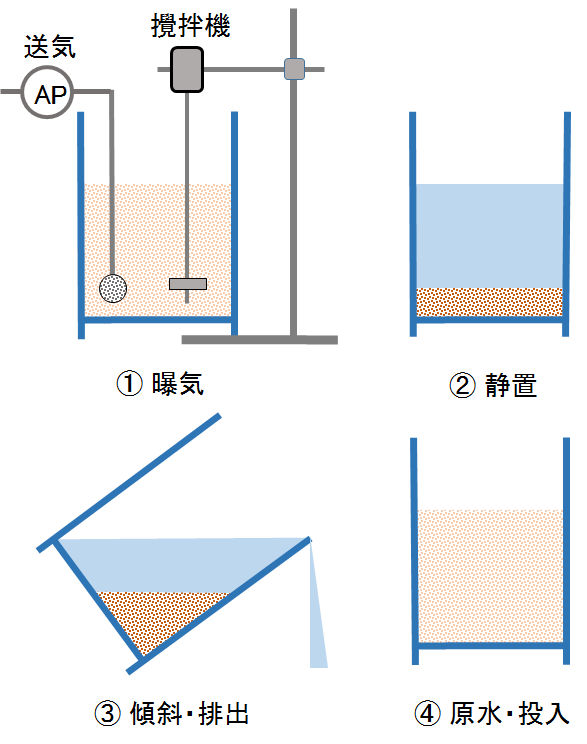
図1 回分式活性汚泥法の操作手順
Fig.1 Operating procedure of batch activated sludge process

写真1 回分式活性汚泥法の実験風景
Photo 1 Scene of an experiment of batch activated sludge method.
(2)供試排水
実験に用いる排水は、生物分解性の汚濁物質を含むものであれば特に限定はない。本実験の目的は活性汚泥法の基本原理と運転操作を理解することにあるので、簡便に入手・利用できることが望ましい。そこで、安価で長期保存が可能であるスキムミルクを主成分とする模擬排水を用いる。この排水の組成と汚濁成分を表1に示す。BOD濃度を800mg-BOD/Lとした理由は、下記の(4) 運転管理と操作条件で述べる。
この模擬排水には炭酸水素ナトリウムを多量に添加している。この量は、排水中の窒素全量を硝酸イオンに酸化(硝化反応)するに必要なアルカリ量に対応している。この組成の排水では、生物反応で消費されるアルカリを外部より添加する必要はない。
他の生活・産業排水を実験に供する場合には、有機物濃度が高い場合にBOD濃度が800mg-BOD/L程度になるよう水道水等で希釈すること、特殊な工業排水では不足する無機塩類などを添加することに留意する。詳細は別ページを参照されたい。
Test wastewater
The wastewater used for the experiment is not particularly limited as long as it contains biodegradable pollutants. Since the purpose of this experiment is to understand the basic principle and operation of the activated sludge method, it is desirable that it can be easily obtained and used. Therefore, simulated drainage containing skim milk as a main component, which is inexpensive and can be stored for a long time, is used. Table 1 shows the composition and pollutant components of this wastewater. The reason for setting the BOD concentration to 800 mg-BOD/L will be described in (4) operation management and operating conditions below.
A large amount of sodium hydrogen carbonate is added to this simulated wastewater. This amount corresponds to the amount of alkali necessary to oxidize all the nitrogen in the waste water to nitrate ions (nitrification reaction). In the wastewater of this composition, it is not necessary to externally add the alkali consumed in the biological reaction.
When using other domestic and industrial wastewater for experiments, dilute it with tap water so that the BOD concentration becomes about 800mg-BOD/L when the organic matter concentration is high, and add inorganic salts that are insufficient with special industrial wastewater. For details, be aware that refer to another page.
Table 1 Composition of simulated wastewater and pollutant components.
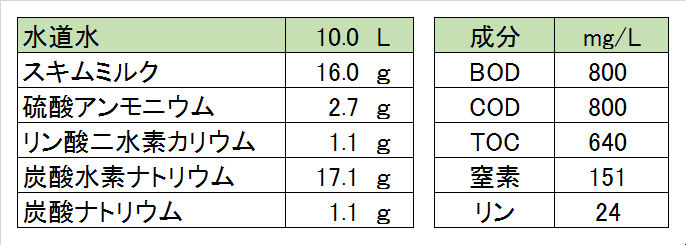
(3)測定機器
温度計に加えて、携帯用のpHメーターおよび溶存酸素メーターがあるとよい。なお、経験の少ない研究室においては、DOの計測制御ができるシステムを勧める。
(3) Measuring instrument
In addition to the thermometer, there should be a portable pH meter and dissolved oxygen meter. In a laboratory with little experience, it is recommend a system that DO can be measure and controled.
(4)操作方法
下水処理場の返送汚泥を10L 程度採取し、30分~1時間程度静置する。上澄み液を排出して、沈降汚泥3Lを実験バケツに移し、模擬排水10L、水道水2L加えて、実験を開始する。
① 模擬排水と汚泥の混合液を攪拌しながら曝気する。攪拌は汚泥が均一に懸濁状になる回転速度とする。過度な攪拌は汚泥フロックを破壊するので注意すること。
② 1日1回、所定の時刻に、表2に記載する所定量の混合液を抜き取る。攪拌・曝気を停止して、30分~1時間程度、静置して浮遊汚泥を沈降させて、汚泥を濃縮する。
③バケツを傾けて、バケツ内の残量が10Lになるまで上澄み液を排出する。18Lポリタンク用電動給油ポンプまたは小型水中ポンプを用いて上澄み液を排出してもよい。このとき、排出液中に汚泥が混入しないよう注意する。排出液の一部をポリ容器(500mL程度)に移して、水質分析に供する。後日、分析する場合には、冷凍庫に保管する。
④ 新たな模擬排水10Lをバケツに投入する。模擬排水を調整せず、水道水10Lをバケツに投入し、表1に示す組成の混合粉末を直接添加してもよい。なお、バケツの内壁に10Lと20Lのレベルにマークを付けておくと操作が迅速にできる。
⑤ 適宜、攪拌・曝気中の混合液の温度、pHおよびDO(溶存酸素濃度)を測定する。
(4) Method of operation
Collect approximately 10L of returned sludge from the sewage treatment plant and leave it for 30 minutes to 1 hour. The supernatant liquid is discharged, 3L of sedimented sludge is transferred to an experimental bucket, 10L of simulated wastewater and 2L of tap water are added, and the experiment is started.
① Aeration is performed while stirring the mixed liquid of simulated wastewater and sludge. Agitation is performed at a rotation speed at which sludge is uniformly suspended. Be careful as excessive agitation destroys sludge flocs.
② Once a day, at a predetermined time, extract a predetermined amount of the mixed solution described in Table 2. Stop stirring and aeration and let stand for 30 minutes to 1 hour to settle the suspended sludge to concentrate the sludge.
③ Tilt the bucket and drain the supernatant until the remaining amount in the bucket is 10L. The supernatant liquid may be discharged using an electric oil pump for 18L plastic tanks or a small submersible pump. At this time, be careful not to mix sludge into the discharged liquid. Transfer a part of the discharged liquid to a plastic container (about 500mL) for water quality analysis. If analyzed at a later date, store in a freezer.
④ Add 10L of new simulated wastewater to the bucket. Or without prepearing the simulated wastewater, 10L of tap water may be added to the bucket, and the mixed powder having the composition of Table 1 may be directly added. If you mark the 10L and 20L levels on the inner wall of the bucket, you can operate it quickly.
⑤ Measure the temperature, pH and DO (dissolved oxygen concentration) of the mixed solution during stirring and aeration appropriately.
3.運転管理と操作条件
初心者にとっては、少々、煩雑に感じるかもしれないが、浮遊型生物処理プロセスの設計・管理の基本であるので、しっかりと理解することが大切である。活性汚泥法に係る用語や計算式については、他ページに記載の解説を参考にされたい。
3. Operation management and operating conditions
It may be a little complicated for beginners, but it is important to understand it thoroughly because it is the basis for designing and managing the floating biological treatment process. For the terms and formulas related to the activated sludge method, refer to the explanations on another page.
(1)負荷量の決定
一般的に、汚水量と汚濁物質濃度から汚水の処理設備の設計を行う。ここでは、実験条件(曝気槽容積:20L、流入量10L、汚水対流時間 HRT = 48h)が決まっているので、先ず、運転に適切な原水中の汚濁物質の濃度を決定する。
曝気槽内の汚泥濃度Sa = 2,500mg-SS/L(仮定)に対して、異なるBOD濃度Ciに対する各操作項目の推定値を表2に、汚泥生成量に係る各推定値を表3に示す。
①BOD汚泥負荷Γsが大きくなると(約0.2kg-BOD/kg-SS以上)と、糸状細菌が増殖しやすい。このことからCiは800mg/L以下が望ましい。
②表3に示すように、Ciが400mg-BOD/L以下では、汚泥の細胞合成量より自己酸化量が大きくなり、汚泥の減少・解体が予想される。
③①および②より、適正なCiは600~800mg-BOD/Lが適切と推定される。
(1) Determination of load amount
Generally, a wastewater treatment facility is designed based on the amount of wastewater and the concentration of pollutants. Here, since the experimental conditions (aeration tank volume: 20L, inflow amount 10L, retention time HRT = 48h) have been determined, first determine the concentration of pollutants in raw water suitable for operation.
For sludge concentration Sa = 2,500mg-SS/L (assumed) in the aeration tank, the estimated value of each operation item for different BOD concentration Ci is Table 2 shows each estimated value relating to the sludge generation amount in Table 3.
① When the BOD sludge load Γs becomes large (about 0.2kg-BOD/kg-SS or more), filamentous bacteria easily grow. From this, Ci is preferably 800mg-BOD/L or less.
② As shown in Table 3, when Ci is 400mg-BOD/L or less, the amount of auto-oxidation becomes larger than the amount of cell synthesis of sludge, and it is expected that sludge will be reduced or dismantled.
③ From ① and ②, it is estimated that 600 to 800 mg-BOD/L is appropriate for proper Ci.
(2)活性汚泥濃度の決定
次に、適切な汚泥濃度を決定する。
④ バケツ内の混合液20Lを静置して、10L(混合液の50%)の上澄液を適正に排出する(汚泥の流出を防ぐ)には、沈降汚泥のSV30を30%程度以下にすることが望ましい。
ここで、SV30 = 30%(仮定)として各汚泥濃度Saに対する汚泥に係る各項目の推定値を表4に示す。
⑤ 正常な活性汚泥のSVIは50~150mL/g-SSのの範囲にあり、200mL/g-SSを超えると汚泥界面が明確でなくなる。Saが4,000mg-SS/L以上では自己酸化量が大きく、汚泥の維持が困難になる。以上のことから、適正な汚泥濃度Saは2,000~3,000mg-SS/Lが適切である。
以上の理由により、本実験では流入水のBOD = 800mg-BOD/L、曝気槽の汚泥濃度Sa = 2,500mg-SS/Lとする。なお、この汚泥濃度を維持するために、余剰汚泥として混合液を、毎日1回700mL程度、抜き取る。このとき、汚泥滞留日数SRTは28日となる。
(2) Determination of activated sludge concentration
Next, determine the appropriate sludge concentration.
④ To allow 20L of the mixed solution in the bucket to stand still and properly discharge 10L (50% of the mixed solution) of the supernatant liquid (to prevent sludge outflow), set the SV30 of the sedimented sludge to about 30% or less. It is desirable to do.
Here, the estimated value of each item related to sludge for each sludge concentration Sa is shown in Table 4 with SV30 = 30% (assumed).
⑤ The SVI of normal activated sludge is in the range of 50 to 150 mL/g-SS, and when it exceeds 200mL/g-SS, the sludge interface becomes unclear. When Sa is 4,000mg-SS/L or more, the amount of auto-oxidation is large and it becomes difficult to maintain sludge. From the above, an appropriate sludge concentration Sa of 2,000 to 3,000 mg-SS/L is appropriate.
For the above reasons, the BOD of the inflow water is 800mg-BOD/L and the sludge concentration of the aeration tank is Sa = 2,500mg-SS/L in this experiment. In addition, in order to maintain this sludge concentration, about 700mL of the mixed solution is withdrawn once a day as excess sludge. At this condition, the sludge retention days SRT is 28 days.
Table 2 Operation management items (1) – BOD load and operating conditions.

Table 3 Operation management items (2) – sludge generation and operating conditions.

Table 4 Operation management items (3) – sludge concentration and operating conditions.

4.実験の自動化
図1の操作を模式化したものが図2である。① 排水の投入、② 攪拌・曝気、③ 停止・静置、④上澄液の排出の操作を1日に数回行う場合には、管理が大変であるので、図3に示す自動化装置にすると便利である。
この実験では、1日分の投入液を回数ごとに分割して投入する。また、投入液のBOD濃度を低くし、1回の投入量を増加(最大10Lまで)することもできる。4回であれば、BOD濃度を200mg-BOD/Lとして、40Lの原排水が処理できる(HRT:12時間)。
4. Experiment automation
Fig.2 is a schematic representation of the operation of Fig.1. When performing operations such as ① inputting waste water, ② stirring and aeration, ③ stopping and settling, and ④ discharging supernatant liquid wichi cycles are several times a day. This management is busy to operate, so it is convenient to use the devices for automation shown in Fig.3.
In this experiment, the input solution for one day is divided and added every number of times. It is also possible to lower the BOD concentration of the input liquid and increase the input amount once (up to 10L). If it is four times, 40L of raw wastewater can be treated with a BOD concentration of 200mg-BOD/L (HRT: 12 hours).
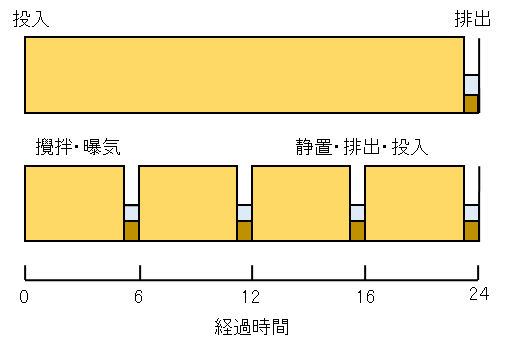
図2 回分法の操作
Fig.2 Batch operation.
5.DO・BOD・窒素の挙動
(1)曝気槽内の組成変化
図4に曝気速度を一定としたときの曝気槽内のDO、BOD、KjNおよびNO3–の濃度変化を示す。なお、図4は代表的な一つの事例であって、投入排水の組成および曝気速度によって様々な挙動を示すことに留意する。
BODは曝気開始とともに減少している。DOは”ゼロ”の状態である。これは、BOD酸化(汚泥の自己呼吸も含む)が酸素の供給速度に依存している状態である。BODが減少して酸素供給速度がBOD酸化速度を超えるようになると、酸素は余剰状態となり飽和状態になる。
KjN(有機態窒素およびアンモニアの合計)は、曝気を開始してからしばらくの間、変化は見られない。BODが減少しておよそ30mg-BOD/L以下になると、硝化反応が進むようになり、NO3–の濃度が増加する。
5. Behavior of DO, BOD and Nitrogen
(1) Composition change in aeration tank
Fig.4 shows changes in the concentrations of DO, BOD, KjN and NO3– in the aeration tank when the aeration rate is constant. Note that Fig.4 is one typical example, and shows various behaviors depending on the composition of the input wastewater and the aeration rate.
BOD decreases with the start of aeration. DO is in the “zero” state. This is a condition in which BOD oxidation (including sludge self-breathing) depends on the oxygen supply rate. When the BOD decreases and the oxygen supply rate exceeds the BOD oxidation rate, the oxygen becomes excessive and becomes saturated.
KjN (total of organic nitrogen and ammonia) does not change for a while after starting aeration. When the BOD decreases to about 30mg-BOD/L or less, the nitrification reaction starts to proceed and the NO3–concentration increases.
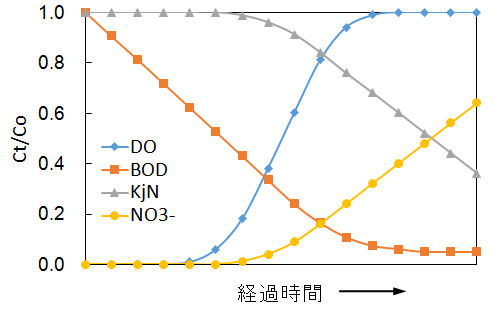
図4 曝気速度一定条件下での回分実験における時間経過と組成変化の事例
Fig.4 Example of time course and composition change in batch experiment under constant aeration rate.
(2)曝気速度
図4から分かるように、BOD除去のみを目的とするならば、曝気量は次回の曝気停止・静置までにDOが上昇する程度でよい。しかし、硝化反応を十分に行うためには適正な曝気量が必要となる。このためには、処理液の窒素分析を行い実験的に設定する。
(2) Aeration rate
As can be seen from Fig.4, if the only purpose is to remove BOD, the amount of aeration should be such that DO increases until the next aeration stop/station. However, an appropriate amount of aeration is required to sufficiently carry out the nitrification reaction. For this purpose, the nitrogen content of the treatment liquid is analyzed and set experimentally.
(3)SRT
硝化反応に係る細菌の増殖速度、BOD酸化菌に比べておよそ1/10といわれる。硝化菌を曝気槽内に保持するためには、一般的にSRTを7~10日以上とする。本実験条件では、3.(2)に記載したように、SRTを28日としているので十分なものである。
(3)SRT
It is said that the growth rate of bacteria involved in nitrification reaction is about 1/10 that of BOD-oxidizing bacteria. In order to keep nitrifying bacteria in the aeration tank, SRT is generally set to 7 to 10 days or longer. Under this experimental condition, 3. As stated in (2), the SRT is 28 days, which is sufficient.
(4)水温
有機物を酸化分解する好気性微生物には、大きく分けて① 低温細菌(16~20℃)、② 中温細菌(25~37℃)および③高温細菌(50~55℃)に分類される。季節の変わり目に低温細菌と中温細菌の変化が起こる。この時期にはバルキングや汚泥フロックの減少・解体など、活性汚泥の働きが不調となる。冬期において15℃以下の低温時には、活性汚泥の機能が低下する。特に、硝化細菌への影響が大きい。加温や負荷量を低減するなどの注意が必要である。
このように季節によって状況が変わるので、年間を通した実験により様々な体験をすることは、将来、実務を担うときの課題解決の参考となろう。
(4) Water temperature
Aerobic microorganisms that oxidize and decompose organic substances are roughly classified into ① psychrophilic bacteria (16 to 20°C), ② mesophilic bacteria (25 to 37°C), and ③ thermophilic bacteria (50 to 55°C). Changes in psychrophilic and mesophilic bacteria occur at the turn of the season. During this period, the functioning of activated sludge becomes sluggish, such as bulking and sludge floc reduction/disassembly. In winter, when the temperature is lower than 15℃, the function of activated sludge deteriorates. In particular, it has a great influence on nitrifying bacteria. It is necessary to take precautions such as heating and reducing the load.
As the situation changes depending on the season, having various experiences through experiments throughout the year will be a reference for solving problems when carrying out practical tasks in the future.
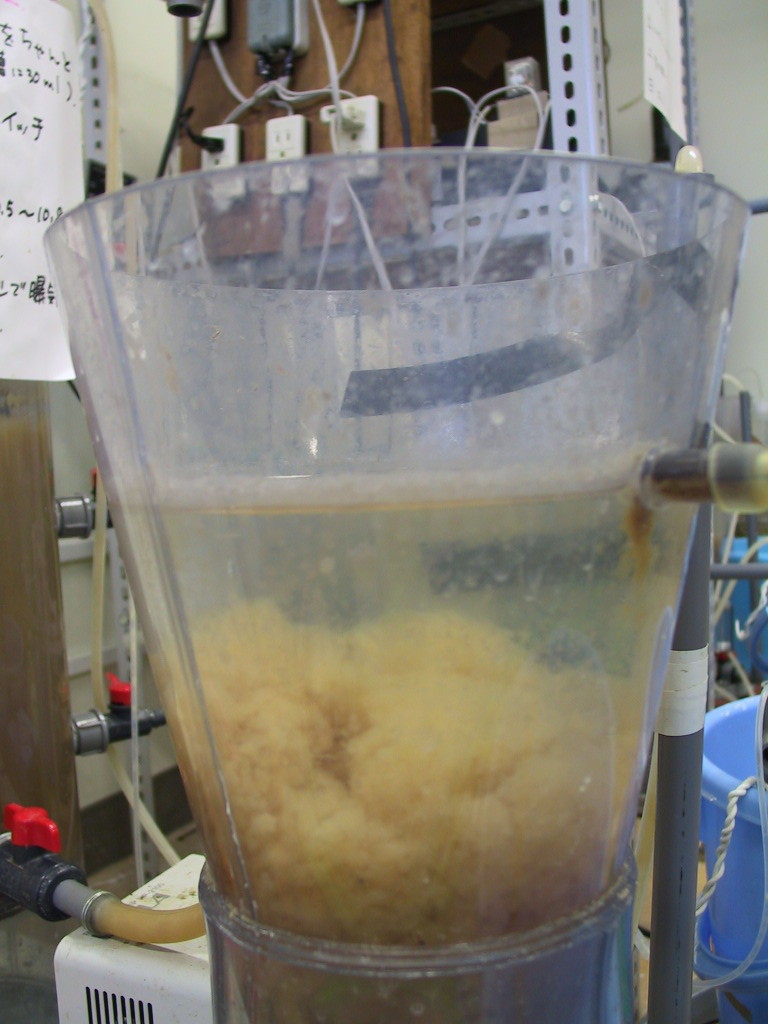
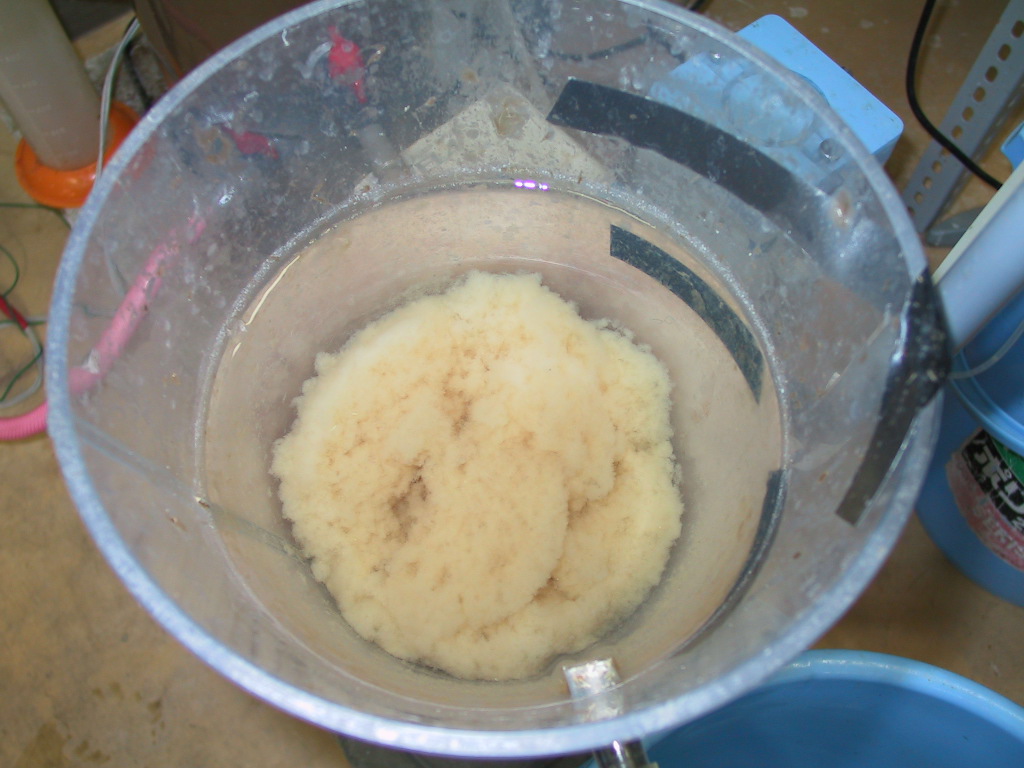
Fig.5 Bulking by filamentous bacteria in activated sludge method.
有機性排水の浄化に関する分析項目
(1)測定項目
実排水に対する研究開発や課題解決を目的するときには、測定する水質項目として、原排水および処理水のBOD、COD、TOC、形態別窒素(有機態、アンモニア態、亜硝酸態、硝酸態の各窒素)、りんなどが望ましい。曝気槽の混合液については、pH、DO、水温、SV30、SVI、MLSSおよびMLVSSなどを測定する。図4に示すような曝気槽内の組成変化を測定する場合には、所定時間ごとサンプリングと分析作業に対して、相当な要員、試薬、機器などの準備と経費が必要である。また、特殊な排水などの処理では、生物種の特定や場合によっては遺伝子解析などが必要となる。
Analysis items for purification of organic wastewater
(1) Measurement item
When researching and developing actual wastewater and solving problems, the water quality items to be measured preferably include BOD, COD, TOC, nitrogen by form (organic, ammonia, nitrite, and nitrate nitrogen), and phosphorus. For the mixed liquid in the aeration tank, measure pH, DO, water temperature, SV30, SVI, MLSS and MLVSS. When measuring composition changes in the aeration tank as shown in Fig.4, it is necessary to prepare a considerable amount of personnel, reagents, equipment, etc. for the sampling and analysis work at predetermined times is necessary. In addition, in the treatment of special wastewater, it is necessary to identify the biological species and, in some cases, to analyze genes.
(2)採取液の保管
採取液は、直ちに水質測定することが望ましい。保管・後日に測定する場合に、プラスチック容器に密封して冷凍庫に保存し、測定日に解凍・測定してもよい。
(2) Storage of collected liquid
It is desirable to measure the water quality of the collected liquid immediately. When storing and measuring at a later date, it may be sealed in a plastic container, stored in a freezer, and thawed and measured on the measuring day.
公開:2017年5月07日
更新:2020年7月21日(英語版追加)
Published: May 7, 2017
Updated: July 21, 2020 (English version added)
